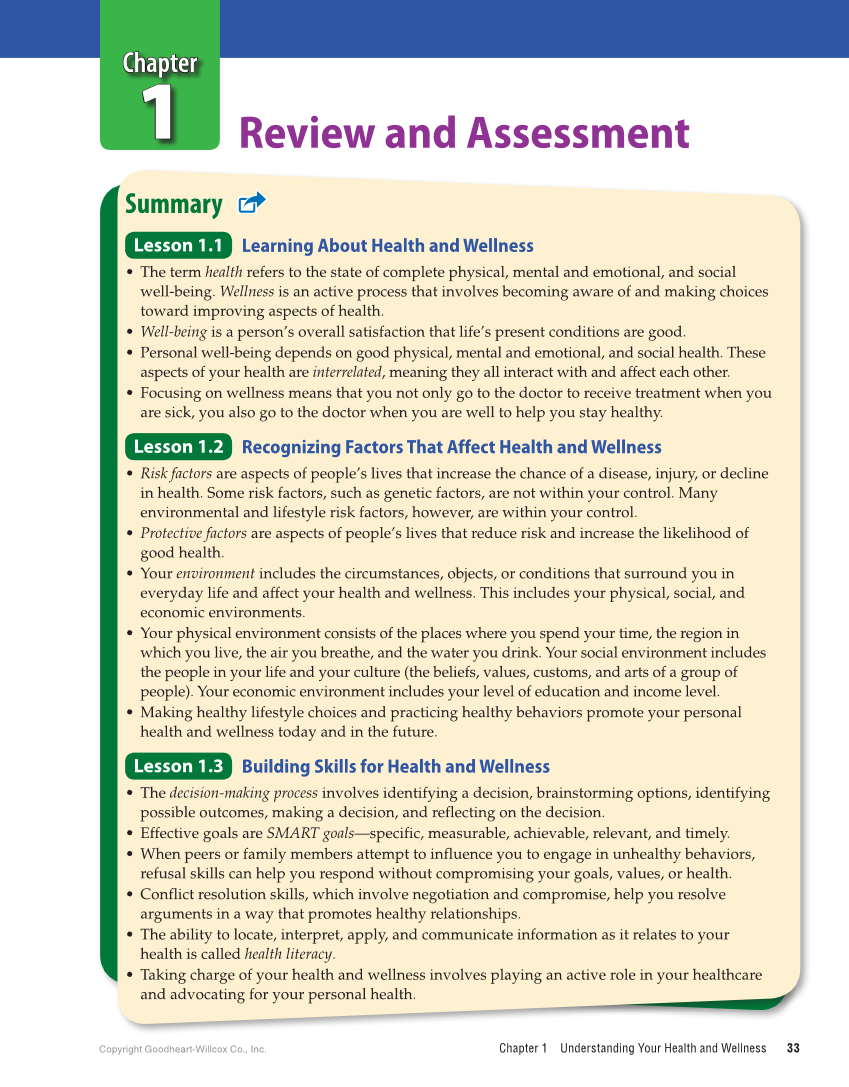Copyright Goodheart-Willcox Co., Inc. Chapter 1 Understanding Your Health and Wellness 33 Summary Lesson 1.1 Learning About Health and Wellness • The term health refers to the state of complete physical, mental and emotional, and social well-being. Wellness is an active process that involves becoming aware of and making choices toward improving aspects of health. • Well-being is a person’s overall satisfaction that life’s present conditions are good. • Personal well-being depends on good physical, mental and emotional, and social health. These aspects of your health are interrelated, meaning they all interact with and affect each other. • Focusing on wellness means that you not only go to the doctor to receive treatment when you are sick, you also go to the doctor when you are well to help you stay healthy. Lesson 1.2 Recognizing Factors That Affect Health and Wellness • Risk factors are aspects of people’s lives that increase the chance of a disease, injury, or decline in health. Some risk factors, such as genetic factors, are not within your control. Many environmental and lifestyle risk factors, however, are within your control. • Protective factors are aspects of people’s lives that reduce risk and increase the likelihood of good health. • Your environment includes the circumstances, objects, or conditions that surround you in everyday life and affect your health and wellness. This includes your physical, social, and economic environments. • Your physical environment consists of the places where you spend your time, the region in which you live, the air you breathe, and the water you drink. Your social environment includes the people in your life and your culture (the beliefs, values, customs, and arts of a group of people). Your economic environment includes your level of education and income level. • Making healthy lifestyle choices and practicing healthy behaviors promote your personal health and wellness today and in the future. Lesson 1.3 Building Skills for Health and Wellness • The decision-making process involves identifying a decision, brainstorming options, identifying possible outcomes, making a decision, and reflecting on the decision. • Effective goals are SMART goals—specific, measurable, achievable, relevant, and timely. • When peers or family members attempt to influence you to engage in unhealthy behaviors, refusal skills can help you respond without compromising your goals, values, or health. • Conflict resolution skills, which involve negotiation and compromise, help you resolve arguments in a way that promotes healthy relationships. • The ability to locate, interpret, apply, and communicate information as it relates to your health is called health literacy. • Taking charge of your health and wellness involves playing an active role in your healthcare and advocating for your personal health. Chapter 1 Review and Assessment
